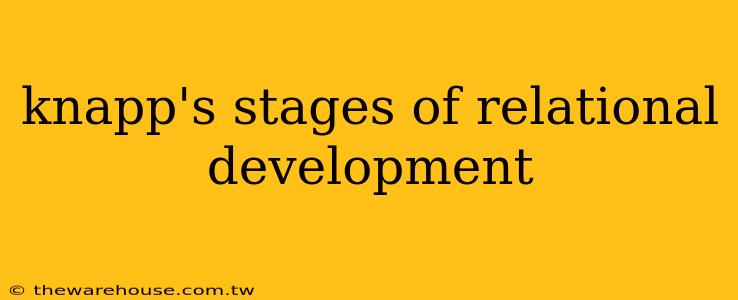Knapp's stages of relational development is a model that outlines the progression of personal relationships through a series of phases. Developed by communication scholar Mark Knapp in the 1970s, this model provides a framework to understand how relationships evolve, whether they are friendships, romantic partnerships, or professional connections. In this article, we will explore each stage in detail, present additional insights, and offer practical examples that illustrate how these stages manifest in real life.
The Five Stages of Knapp's Model
Knapp's model consists of ten stages, divided into two main categories: coming together and coming apart. The five stages of coming together are:
1. Initiating
- Description: The initiating stage occurs when individuals first meet and interact. This stage involves initial greetings and small talk, as well as first impressions.
- Example: When two people are introduced at a social event, they might share their names and engage in light conversation about mutual interests.
2. Experimenting
- Description: During the experimenting stage, individuals seek to learn more about each other by asking questions and sharing information. This stage often includes flirting or sharing personal stories.
- Example: Two colleagues may start to have lunch together, asking about each other's work backgrounds and hobbies to discover commonalities.
3. Intensifying
- Description: As individuals grow closer, the intensifying stage involves increased self-disclosure and emotional connection. Couples often express affection and may begin to label the relationship (e.g., boyfriend/girlfriend).
- Example: Friends might start using terms of endearment and begin spending more time together, deepening their bond through shared experiences.
4. Integrating
- Description: In the integrating stage, individuals start to merge their lives, displaying a sense of commitment and unity. This stage often involves introducing each other to family and friends.
- Example: A couple might move in together or begin planning vacations as a team, symbolizing their commitment to each other.
5. Bonding
- Description: The bonding stage marks a formal commitment to the relationship, such as engagement or marriage. This stage often includes public declarations of commitment.
- Example: A couple getting engaged is a clear indicator of the bonding stage, demonstrating their intention to build a life together.
The Coming Apart Stages
In addition to the coming together stages, Knapp's model also outlines five stages of coming apart:
1. Differentiating
- Description: The differentiating stage is characterized by individuals beginning to assert their individuality within the relationship. This can lead to conflict if not managed carefully.
- Example: A couple may start to prioritize their own hobbies and interests over time spent together, leading to discussions about personal space.
2. Circumscribing
- Description: In this stage, communication decreases and certain topics may become off-limits. Partners may limit their interactions to safe subjects to avoid conflict.
- Example: A couple may only discuss practical matters like finances or household chores, avoiding deeper conversations about their feelings.
3. Stagnating
- Description: The stagnating stage represents a standstill in the relationship where partners feel disconnected and may go through the motions without genuine engagement.
- Example: A couple that no longer seeks to spend time together or share their lives may find themselves stuck in a rut.
4. Avoiding
- Description: During the avoiding stage, partners actively try to distance themselves from each other, physically and emotionally. This stage can involve a range of behaviors from passive to overt avoidance.
- Example: One partner may choose to work late or spend time with friends rather than face their partner at home, indicating a desire to avoid confrontation.
5. Terminating
- Description: The terminating stage marks the end of the relationship. This stage involves formalizing the separation, whether through a breakup or divorce.
- Example: A couple may have a serious discussion about their future and decide to part ways, signifying the culmination of their relationship journey.
Analysis and Additional Insights
Understanding Knapp's stages of relational development can be incredibly beneficial for personal and professional relationships. By recognizing where a relationship stands within these stages, individuals can better navigate their interactions and address potential issues proactively.
Practical Example: Navigating a Romantic Relationship
Consider a couple that has been dating for several months. They might start in the initiating stage, characterized by exciting first dates and initial chemistry. As they progress to the experimenting stage, they share more personal details, increasing their connection. However, if they reach the differentiating stage, it’s crucial for them to communicate openly about their needs and maintain a balance between togetherness and individuality.
SEO Keywords for Optimization
To ensure that this article reaches a wider audience, several keywords can be integrated throughout the content. These include:
- Knapp's stages of relational development
- relationship dynamics
- stages of intimacy
- communication in relationships
- understanding personal relationships
Conclusion
Knapp's stages of relational development offer a valuable framework for understanding how personal relationships evolve. By recognizing the different stages, individuals can foster healthier connections and navigate challenges more effectively. Whether you are building new friendships or managing romantic partnerships, being aware of these stages can enhance your relationship skills and lead to deeper, more fulfilling connections.
References
For more detailed explanations and discussions on this topic, you can refer to Academia.edu where scholars and students share academic papers, including studies related to relational development and communication. Remember to engage with the content and follow the original authors for further insights.
This content is structured to be informative and engaging while integrating practical examples and analysis, ensuring that readers find real value in understanding Knapp's stages of relational development.
